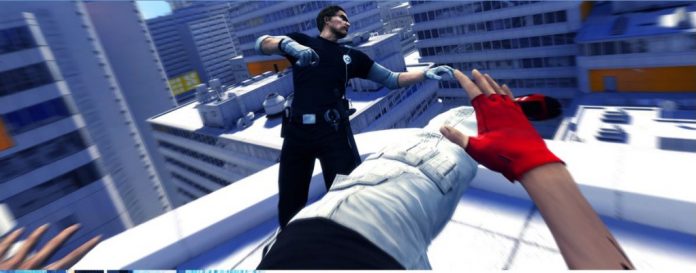Released in late 2008, Mirror’s Edge shared shelve space with such heavy-hitters as Call of Duty: World at War, Battlefield: Bad Company, and Fallout 3 , causing it to be generally overlooked. Failing to meet low sales expectations, the game by EA developer DICE, the same people who brought you the Battlefield franchise, only moved around 1 million copies of the game in 2008. (http://www.shacknews.com/article/57075/mirrors-edge-dead-space-break) It is safe to say, this game has generally been overlooked by the general target audience, despite its unique and extremely addictive gameplay coupled with an art style that sets it apart from the average first-person game.
Notice, however, I did not call it a first-person shooter. While it is true that the game does, in fact, have guns, the actual shooting and gunplay mechanics are far from the center of focus in Mirror’s Edge. “Then what,” you might ask yourself “is the point of this game?” It’s plain and simple: parkour. As many of you might already know, parkour is the sport of getting from point A to point B in the fastest way possible through an urban environment. Mirror’s Edge tries to capture this high flying excitement in a scenic metropolis environment mixing in momentum-based melee combat and basic shooting mechanics.
Gameplay:
At its very core, Mirror’s Edge is all about how the player moves Faith, the protagonist, around her environment using a simple to learn yet hard to master control scheme. As the player traverses the environment, whether it be over the sun-soaked rooftops or below in the damp sewers, they can gain speed and momentum by successfully chaining moves without faltering in an effort to either beat the level in record time or just enjoy the satisfaction that comes with traversing the terrain in such an elegant fashion. You’ll first start by learning wall-runs and vaults, but you’ll soon be roof jumping at incredible speeds in no time. There is no comparison to any other game that will do the movement system justice (excluding the soon to be released game Titianfall which is currently in beta at the time of writing.) The simple feeling of speed is exhilarating, and no moment can compare to when you pull off a complicated chain of moves on instinct alone. But, there are still two other components to the gameplay: path-finding and combat.
In the levels, it is not always easy to find your way; there can be seemingly impassible electric fences or un-jumpable gaps. It’s not a puzzle, per-say, but it is an additional challenge. Personally I think “path-finding problems” are appropriate names that simply describe the developer’s attempts at breaking up the fluid movement to put the player to the test. In all, they are a welcome part of the game, but, to me, they seem to get in the way of the flow of the game a little too often. Finally, there is the combat system that is comprised of unarmed and armed fighting. Early in the game, you are able to take a more non-lethal approach to the police that are trying to stop you, if you so please. By gaining speed before dealing a blow, you can do more damage to your enemy and even knock them out in a single hit. Alternatively, you can disarm them using a well timed button press during the enemy’s melee animation. Later in the game, however, the average traffic cop is replaced with armored soldiers that will shoot you dead in just a few shots. You have no choice but to take a gun from one of them and return fire which will often be a multi-death process. There is no aiming down sights, bullet count, or even reloading while handling a gun in addition to your impaired parkour skills. This barebones shooting is implemented in order to emphasize the fact that Faith is not a fighter but a runner. However, this can often lead to frustration. A great deal of frustration, in fact.
Narrative:
Unlike the six FPS’s in recent memory that involved Russians and nuclear devices in some way (this is not an exaggeration), Mirror’s Edge tries not to be too serious or generic in the story it is trying to tell. Unfortunately, it seems that the story was mostly an afterthought only constructed to justify the unnamed mega-city that Faith calls home. Using the theme in the story of David and Goliath, Faith and the other “Runners” serve as the communication life lines for the small resistance against seemingly perfect new city government. It is never truly fleshed out why the new city is so inherently bad, except for a violent coming-to-power which leaves me questioning the characters’ motives and feeling that nothing deeper than a kiddy pool is explained. Of the handful of people you meet in the game, a grand total of zero have any form of character development. They seem to be put in place simply to move the plot along without any real emotion tagged on. The voice acting is neither good nor bad, but that isn’t saying much due to the bland dialogue. Nevertheless, it still ranks better in my book than the countless games in recent years that have had no original story at all to speak of.
Visuals and Audio:
Mirror’s Edge basically dabbles in two artistic realms: in-game visuals as a photorealistic but artistically done environment and cut-scenes as comic book-esc slides to tell the story. Put side by side, they complement each other quite well; the “real” world feels as though it is only a few steps and a dimension away from the comic. If Ikea and a frozen yogurt boutique had a child that designed a city, it would be the world of Mirror’s Edge. I struggle to find a better way to explain it. The ample use of white with the bright fruitful accents throughout the world give the entire setting a refreshed feeling, like lemonade for the eyes. With this setting in mind, the composers of the atmospheric tracks did an impeccable job matching the exact tone that resonated from the environment. In addition to this, the main theme for Mirror’s Edge ranks among the best I have ever heard from in a game. Again, the theme intertwined with the stunning visuals evokes an emotion tug in my chest that surely does not come from the one dimensional plot.
Conclusion:
When taking into account the strong female lead, light “puzzle” solving, first person perspective, comparatively shorter campaign, and copious amounts of white, a celebrated game comes to mind. Still not sure what it is? Here’s a hint: both games have their credit song titled “Still Alive.” However, it is unfair to compare Mirror’s Edge to Portal due to fundamental gameplay differences. But, they do share a certain spark, a certain something about them that can’t easily be found in other games. This something is the breath of fresh air, the breaking away from trends, the creative liberty of the developer that most big games have been void of recently. Did either of these games change the industry? Not really. Did they at least leave a lasting mark? From all the jokes, the community following, and small first-person-puzzler genre it spawned, Portal clearly left a mark but, Mirror’s edge did not get the chance to.






